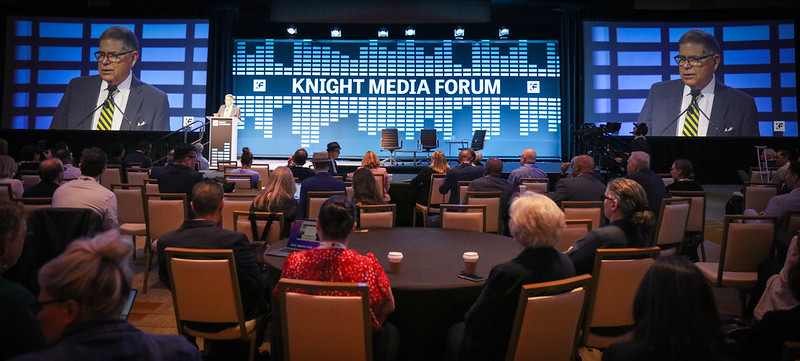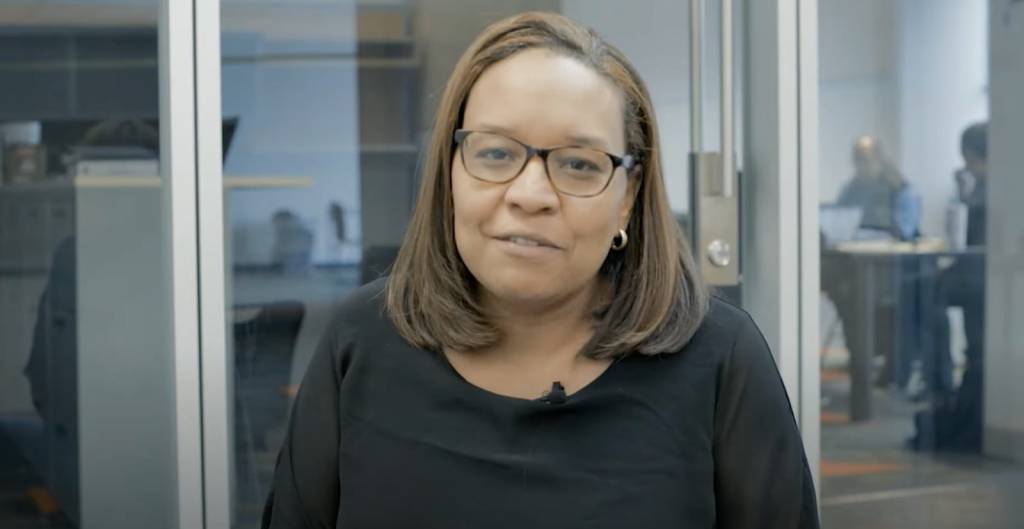
6 Takeaways from the 2023 Knight Media Forum
16th edition of the conference focuses on solutions for local news, diversity initiatives and political polarization

For the 16th edition of the Knight Media Forum in Miami (and online), there was a sense of optimism not seen for some time. This felt like a moment of potential transformation in local news. There are all sorts of nonprofit startups springing up, fantastic collaborations taking shape, new products developed to support the field and early discussions of a drive to initiate a massive collaborative funding effort for local news.
Most importantly, we were back in Miami in person for the first time since 2020, and it was gratifying to see so many familiar faces from the world of philanthropy, news publishing and civic engagement. It felt like a family reunion. Through plenary sessions and breakouts, we discussed racial healing, local news startups, business sustainability, political polarization, technology and new media platforms and social media regulation.
Here are some key takeaways from the Knight Media Forum this year:
1. Knight announces new investments in Akron.
Knight CEO Alberto Ibargüen gave a rousing opening speech describing how times have changed for media consumption and for KMF. At the original gathering of community and regional foundations in 2007, 98 percent of people were getting local news from newspapers. This year, the 265 foundation leaders at KMF––representing 103 communities across the country and the world––are facing a system with a multitude of places to get news, along with major problems regarding misinformation and trust.
“Our purpose remains the same as it was at the start: to explore ways to maintain an informed citizenry, without which democracy fails,” Ibargüen said. “But our focus has shifted over the years from funders, to media technology, to local journalism, to the informed communities themselves.” He also noted that the time had come to be on the offensive and not on the defensive.
Ibargüen announced that Knight was investing $5 million in Signal Akron, a satellite in the new Signal Ohio constellation, with Signal Cleveland having launched last fall. Local donors and philanthropy, together with the American Journalism Project (AJP), will nearly match Knight’s investment, bringing the total to $9.5 million. Akron is a crucially important city in the Knight universe, as the former Rubber Capital of the World is the hometown of Jack Knight.
2. Black publishers increase sustainability as a racial healing effort reaches new audiences.
The KMF kickoff panel showcased the power of collaboration with the Knight x LMA BloomLab, an effort to transform 26 Black-owned local media outlets around the country through three cohorts. The first cohort was made up of the 10 publishers who had been part of the Word In Black collaborative, and each was supported by a $50,000 technology grant, business consulting and shared learning opportunities.
What are the results so far? The first cohort saw an increase in digital revenues of 131 percent in the first year, along with a 21 percent increase in total revenues. “When you think of technology, think of it as making a cake and someone gives you a mixer, and you say ‘What’s that?’” said Sonny Messiah Jiles of Defender Media Group. “‘It’s more efficient, faster––‘Damn, I want a mixer!’ That’s what the technology does for publishers. BloomLab introduced us to BlueLena, [which] allows you to understand how to make the most of your newsletters, understand your audience.”
A later panel showcased the work around the National Day of Racial Healing in a collaboration between NBCUniversal News Group and the W.K. Kellogg Foundation. While the foundation had been running the event over the past six years, it typically had a small audience on YouTube. Collaborating with NBC brought a much larger audience, as more than 1 million people participated in just the first weekend this year.
This collaboration was also able to focus on Buffalo after a lot of local groundwork was laid on the racial healing front, even before the tragic shooting at the Tops Friendly Market. “What we at the foundation knew, in the community of East Buffalo and beyond, is that they’ve been doing racial healing work for awhile,” said Stephanie Dukes, communications officer at Kellogg. “Community foundations across races came together and responded to that situation because they were prepared. Everyone picked up the phone when the news came out, knowing the groundwork they laid with racial healing work would be important in responding to the moment.”
3. Nonprofit news startups are scaling up, serving more communities.
We’ve seen the launches of large metro nonprofit news outlets in Baltimore, Cleveland and elsewhere, but how can they scale up to cover more communities? The American Journalism Project has been pushing for a network effect in states that need local news coverage beyond the largest cities. In addition to funding Signal Ohio—its first site being Signal Cleveland, with Signal Akron to follow—it also funded Mississippi Today, which now has a sister nonprofit site called Verite in New Orleans. Mississippi Today has made waves breaking news about the Jackson water crisis and the misappropriation of $77 million in welfare funds.
Plus, Cleveland Documenters—citizen journalists paid to cover public meetings—helped pave the way for the “resident-first” viewpoint of Signal Cleveland. “We will have a networked model . . . so the idea is to have a hub that supports news outlets around the state,” said Lila Mills, editor-in-chief of Signal Cleveland. “We have 18 folks in Cleveland, with two on product development. The vision is that we have this great support from philanthropy, it’s about 100 percent of our support. But we started with some corporate support and will have three areas of income: philanthropy, corporate sponsorships and reader revenue through memberships.”

4. The state of local news is much improved, more optimistic.
How is local media different today from five years ago? That was my opening question to the rapid-fire panel on “The Big Picture” in local news. And the answers were largely positive. Five years ago, the message was about doom and gloom in local news and now there’s more optimism for experimentation, said Graciela Mochkofsky, dean of the Craig Newmark Graduate School of Journalism. And Institute for Nonprofit News CEO and executive director Sue Cross said she can’t see us going back to the days of gloom and doom.
“We are seeing local news growing in so many ways,” Cross said. “People are getting local news, creating it, and finding it in new ways. It won’t be the same way as before. . . The key is to look at the sustainability of news organizations, with funders focused on economic sustainability, but it varies from community to community. We won’t find a magic formula for business, it’s developing place by place, news outlet by news outlet.”
5. Excitement builds around an initiative created to catalyze millions of new dollars for local news.
Many of us engaged in discussion about a potentially significant collaborative effort that would catalyze new funding for local news and include as many funders as possible. It’s an initiative that sets the stage for philanthropists to have an even greater impact across the local news ecosystem by helping communities become more informed and engaged. But we’re still workshopping some of the details.
On the “Journalism Funding Collaboration” panel, Kristen Mack of MacArthur Foundation spoke forcefully for the national initiative, while Jeff Cohen from Arnold Ventures explained he wasn’t quite ready to “sign a pledge card” yet.
“Now is the time to respond, to focus on local news,” said Mack, “We are asking for a coalition of the enthusiastic to join us to meet a need.” She mentioned the “5 D’s” to respond to this moment, including bolstering democracy, supporting greater diversity, being digital in orientation, developing long-term sustainable models and driving demand for high-quality coverage to meet information needs. This was indeed taking the offensive.

6. Political polarization threatens democracy, but the majority of Americans are frustrated moderates.
It feels like we are in a moment of increasing polarization and division in America, as more extreme points of view spread on social media and primary elections lead to far-right and far-left candidates for general elections. And the national media plays a role in focusing on these more extreme politicians, leading to less trust in national news.
Former Maryland Gov. Larry Hogan discussed how he was able to become governor of the “bluest state in America” as a Republican by working across the aisle to come up with solutions that worked for more people. He also fought disinformation as chair of the National Governors Association during the pandemic.
“We managed the crisis, helped to vaccinate millions of people, balance lives and livelihoods, and one important part is the media and our communication,” Hogan said. “We were getting confusing information from Washington and around the nation, and a tremendous amount of disinformation. . . [People wanted] to get the facts, and we had the highest marks, 86 percent approved of our actions, including clear communication.”
Darren Walker, president of the Ford Foundation, noted that America really only became a full democracy with everyone having the right to vote in 1965. He has hope in seeing the large turnouts for elections, especially in Georgia.
“For much of this country’s history, democracy has not been practiced. Now we’re seeing a real expression of democracy,” he said. “More of our citizenry can be engaged and get motivated to go to the polls and participate in the public square. There’s no more patriotic idea than having the highest turnout of all the citizens. Elections of the past two years, and especially the Georgia Senate race, have had the highest participation of citizens of the state. And they elected a Black and a Jew. So it’s not about the party, it’s about the representation of the fullness of the country that we are.”
*****
News @ Knight Credits
Written by Jim Brady, with Mark Glaser
Edited by Jim Brady, Jessica Clark and Kara Pickman
A Knight + Dot Connector Joint
Recent Content
-
Journalism / Article
-
Journalism / Article
-
Journalism / Article


